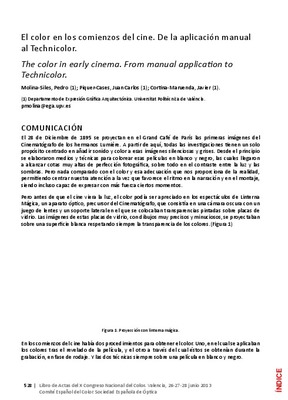JavaScript is disabled for your browser. Some features of this site may not work without it.
Buscar en RiuNet
Listar
Mi cuenta
Estadísticas
Ayuda RiuNet
Admin. UPV
Desde el lunes 3 y hasta el jueves 20 de marzo, RiuNet funcionará en modo de solo lectura a causa de su actualización a una nueva versión.
El color en los comienzos del cine. De la aplicación manual al Technicolor
Mostrar el registro completo del ítem
Molina Siles, PJ.; Piquer Cases, JC.; Cortina Maruenda, FJ. (2013). El color en los comienzos del cine. De la aplicación manual al Technicolor. http://hdl.handle.net/10251/30118
Por favor, use este identificador para citar o enlazar este ítem: http://hdl.handle.net/10251/30118
Ficheros en el ítem
Metadatos del ítem
| Título: | El color en los comienzos del cine. De la aplicación manual al Technicolor | |
| Otro titulo: |
|
|
| Autor: | ||
| Entidad UPV: |
|
|
| Fecha difusión: |
|
|
| Resumen: |
El 28 de Diciembre de 1895 se proyectan en el Grand Café de París las primeras imágenes del Cinematógrafo de los hermanos Lumière. A partir de aquí, todas las investigaciones tienen un solo propósito centrado en añadir ...[+]
On 28 th December 1895 the first images of the cinema of the Lumière brothers are projected at the Grand Café in Paris. Since there, all investigations have focused on a single purpose, add sound and color to these silent ...[+]
|
|
| Palabras clave: |
|
|
| Derechos de uso: | Reserva de todos los derechos | |
| ISBN: |
|
|
| Fuente: |
|
|
| Editorial: |
|
|
| Título del congreso: |
|
|
| Lugar del congreso: |
|
|
| Fecha congreso: |
|
|
| Descripción: |
|
|
| Tipo: |
|







